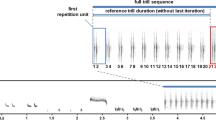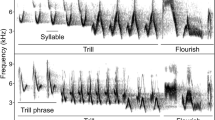Abstract
In signalling interactions, animals can directly address information to a specific individual. Vocal overlapping is such a signalling strategy used in songbirds, anurans, and insects. In songbirds, numerous studies using high rates of song overlap to simulate an escalating situation have shown that song overlapping is perceived as a threatening signal by interacting and by listening (eavesdropping) individuals, indicating a high social relevance of song overlapping. Here we present a playback experiment on nocturnally singing male territorial nightingales (Luscinia megarhynchos). Using three different rates of song overlap (1, 25, or 50%), we tested whether or not lower levels of song overlapping act as a signal of aggressive intent and if birds would increase the intensity of their response with increasing level of song overlapping. Subjects did not vary song duration in response to the different playback treatments but increasingly interrupted their singing with increasing overlap by the three playback treatments. The effects persisted even after the playback ceased to overlap and switched to an alternating singing mode. These results expand on previous studies by showing that song overlapping is interpreted as an aggressive signal even when it is used at low or moderate levels. They suggest that, within the range tested here, increasing levels of song overlapping are perceived to be increasingly aggressive.




Similar content being viewed by others
References
Amrhein V, Korner P, Naguib M (2002) Nocturnal and diurnal singing activity in the nightingale: correlations with mating status and breeding cycle. Anim Behav 64:939–944
Amrhein V, Kunc HP, Naguib M (2004) Seasonal patterns of singing activity vary with time of day in the nightingale. Auk 121:110–117
Axelrod R, Hamilton WD (1981) The evolution of cooperation. Science 211:1390–1396
Barnard C (2004) Animal behaviour: mechanisms, development, function and evolution. Pearson, Prentice Hall, Harlow
Beecher MD, Campbell SE, Burt JM, Hill CE, Nordby JC (2000) Song-type matching between neighbouring song sparrows. Anim Behav 59:21–27
Brindley EL (1991) Response of European robins to playback of song: neighbor recognition and overlapping. Anim Behav 41:503–512
Brockmann HJ (2001) The evolution of alternative strategies and tactics. Adv Study Behav 30:1–51
Catchpole C, Slater PJB (1995) Bird song: biological themes and variations. Cambridge University Press, Cambridge, England
Dabelsteen T, McGregor PK, Shepherd M, Whittaker X, Pedersen SB (1996) Is the signal value of overlapping different from that of alternating during matched singing in Great Tits? J Avian Biol 27:189–194
Dabelsteen T, McGregor PK, Holland J, Tobias JA, Pedersen SB (1997) The signal function of overlapping singing in male robins. Anim Behav 53:249–256
Gerhardt HC, Huber F (2002) Acoustic communication in insects and anurans: common problems and diverse solutions. University of Chicago Press, Chicago
Gil D, Gahr M (2002) The honesty of bird song: multiple constraints for multiple traits. Trends Ecol Evol 17:133–141
Godard R (1993) Tit-for-tat among neighboring hooded warblers. Behav Ecol Sociobiol 33:45–50
Greenfield MD (1994) Cooperation and conflict in the evolution of signal interactions. Ann Rev Ecolog Syst 25:97–126
Hultsch H, Todt D (1981) Repertoire sharing and song-post distance in nightingales (Luscinia megarhynchos B.). Behav Ecol Sociobiol 8:183–188
Hultsch H, Todt D (1982) Temporal performance roles during vocal interactions in nightingales (Luscinia megarhynchos). Behav Ecol Sociobiol 11:253–260
Hyman J (2002) Conditional strategies in territory defense: do Carolina wrens play tit-for-tat? Behav Ecol 13:664–669
Kipper S, Mundry R, Hultsch H, Todt D (2004) Long-term persistence of song performance rules in nightingales (Luscinia megarhynchos): a longitudinal field study on repertoire size and composition. Behaviour 141:371–390
Kipper S, Mundry R, Sommer C, Hultsch H, Todt D (2005) Song repertoire size is correlated to body measures and arrival date in common nightingales (Luscinia megarhynchos). Anim Behav (in press)
Krebs JR, Ashcroft R, van Orsdol K (1981) Song matching in the great tit Parus major L. Anim Behav 29:918–921
Kroodsma DE (1989) Suggested experimental designs for song playbacks. Anim Behav 37:600–609
Kunc HP, Amrhein V, Naguib M (2005) Vocal interactions in nightingales (Luscinia megarhynchos): more aggressive males have higher pairing success. Anim Behav (in press)
Langemann U, Tavares JP, Peake TM, McGregor PK (2000) Response of great tits to escalating patterns of playback. Behaviour 137:451–471
Leboucher G, Pallot K (2004) Is he all he says? Intersexual eavesdropping in the domestic canary, Serinus canaria. Anim Behav 68:957–963
McGregor PK (2005) Communication networks. Cambridge University Press, Cambridge
McGregor PK, Dabelsteen T, Shepherd M, Pedersen SB (1992) The signal value of matched singing in great tits—evidence from interactive playback experiments. Anim Behav 43:987–998
Mennill DJ, Ratcliffe LM (2004a) Overlapping and matching in the song contests of black-capped chickadees. Anim Behav 67:441–450
Mennill DJ, Ratcliffe LM (2004b) Do male black-capped chickadees eavesdrop on song contests? A multi-speaker playback experiment. Behaviour 141:125–139
Mennill DJ, Ratcliffe LM, Boag PT (2002) Female eavesdropping on male song contests in songbirds. Science 296:873
Miyazaki M, Waas JR (2002) ‘Last word’ effects of male advertising calls on female preference in little blue penguins. Behaviour 139:1413–1423
Naguib M (1999) Effects of song overlapping and alternating on nocturnally singing nightingales. Anim Behav 58:1061–1067
Naguib M (2005) Singing interactions in song birds: implications for social relations, territoriality and territorial settlement. In: McGregor PK (ed) Communication networks. Cambridge University Press, Cambridge, pp 300–319
Naguib M, Todt D (1997) Effects of dyadic vocal interactions on other conspecific receivers in nightingales. Anim Behav 54:1535–1543
Naguib M, Fichtel C, Todt D (1999) Nightingales respond more strongly to vocal leaders in simulated dyadic interactions. Proc R Soc Lond B 265:537–542
Naguib M, Amrhein V, Kunc HP (2004) Effects of territorial intrusions on eavesdropping neighbors: communication networks in nightingales. Behav Ecol 6:1011–1015
Otter K, McGregor PK, Terry AMR, Burford FRL, Peake TM, Dabelsteen T (1999) Do female great tits (Parus major) assess males by eavesdropping? A field study using interactive song playback. Proc R Soc Lond B 266:1305–1309
Peake TM, Terry AMR, McGregor PK, Dabelsteen T (2001) Male great tits eavesdrop on simulated male-to-male vocal interactions. Proc R Soc Lond B 268:1183–1187
Peake TM, Terry AMR, McGregor PK, Dabelsteen T (2002) Do great tits assess rivals by combining direct experience with information gathered by eavesdropping? Proc R Soc Lond B 269:925–1929
Rice WR, Gaines SD (1994) Extending nondirectional heterogeneity tests to evaluate simply ordered alternative hypothesis. Proc Natl Acad Sci U S A 91:225–226
Stamps JA, Krishnan VV (2001) How territorial animals compete for divisible space: a learning-based model with unequal competitors. Am Nat 157:154–169
Todt D (1971) Äquivalente und konvalente gesangliche Reaktionen einer extrem regelmäßig singenden Nachtigall (Luscinia megarhynchos). Z Vgl Physiol 71:262–285
Todt D (1981) On functions of vocal matching: effects of counter-replies on song post choice and singing. Z Tierpsychol 57:73–93
Todt D, Naguib M (2000) Vocal interactions in birds: the use of song as a model in communication. Adv Study Behav 29:247–296
Vehrencamp SL (2001) Is song-type matching a conventional signal of aggressive intentions? Proc R Soc Lond B 268:1637–1642
Waser PM, Wiley RH (1980) Mechanisms and evolution of spacing in animals. In: Marler P, Vandenbergh JG (eds) Handbook of behavioral neurobiology: social behavior and communication, vol 3. Plenum, New York, pp 159–233
Whitfield J (2002) Nosy neighbors. Nature 419:242–243
Wiley RH (2003) Is there an ideal behavioural experiment? Anim Behav 66:585–588
Acknowledgements
We thank Henrik Brumm, Friederike Kießelbach, and Christina Sommer for assistance in the field. Valentin Amrhein, Nicolas Mathevon, Robert Gibson, and two anonymous referees provided valuable comments on a previous version of the manuscript.
Author information
Authors and Affiliations
Corresponding author
Additional information
Communicated by R. Gibson.
Rights and permissions
About this article
Cite this article
Naguib, M., Kipper, S. Effects of different levels of song overlapping on singing behaviour in male territorial nightingales (Luscinia megarhynchos). Behav Ecol Sociobiol 59, 419–426 (2006). https://doi.org/10.1007/s00265-005-0066-z
Received:
Revised:
Accepted:
Published:
Issue Date:
DOI: https://doi.org/10.1007/s00265-005-0066-z




